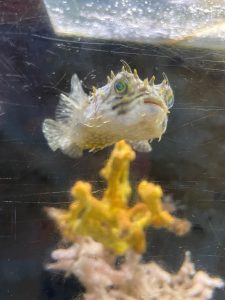
I have a vivid memory of snorkeling the seagrass beds around Port St. Joe when I was an undergraduate marine biology student. Our field research lab involved completing a visual fish survey, using waterproof dive slates and pencils to record the number and species of any fish that swam past us. I was conducting my survey fairly rigorously until a 6” long striped burrfish (Chilomycterus schoepfi) moved into my field of vision. It hovered in front of me, looking over with its gigantic puppy-like eyes, and proceeded to gently nibble on everything in sight. There are very few fish one might characterize as “cute,” but this charismatic little guy was adorable. Completely abandoning the task at hand, I stopped counting other fish and proceeded to slowly swim behind this little burrfish as it fed and swam throughout the grass bed. It was completely unfazed by my presence—I stopped to watch while it ate, then used my flippers to slowly navigate behind when it started moving again. I must have followed this fish for 30 minutes, simply observing its behavior. I could have sworn it looked back and me and signaled, “come on!” with a fin every time it moved to another location. I’ve snorkeled countless times since then, but bonding with this little fish was such a singular experience that I can visualize it clearly almost 30 years later.

Hence, I’ve always had a soft spot for the striped burrfish. We occasionally pull juveniles up in a seine when taking groups out in the field, and they often puff up in response to the shock of being temporarily captured. Frequently misidentified as their Tetradont relatives, the Southern puffer (Spheroides nephelus), the burrfish is similar in size and habitat. However, they are fairly easy to differentiate by their dorsal color patterns. As the name implies, striped burrfish have brown stripes, while puffers have more of a mottled pattern. Both species have bright white countershading on their bellies (aka “ventral” side), helping them blend in with the sky above when viewed from below by potential predators. They also utilize similar defense mechanisms, filling their bodies with air or water when threatened so they physically expand, appearing bigger and more difficult to fit into a larger fish’s mouth. Burrfish also have rigid spines that point out from their bodies when in self-defense mode. This adaptation makes them more complicated to digest for a would-be attacker. Many members of this Order of fishes produce a dangerous neurotoxin, further deterring predatory attacks.

To the human observer, it’s anything but intimidating to see a fish transform into a ping pong ball with fins, but the strategy must work because there are around 120 species of puffers and porcupinefish in the Order Tetraodontiformes that use this technique.
As young burrfish mature, their front teeth fuse into a tough “beak,” which they use to break through the shells of their prey. As I experienced while snorkeling, burrfish are slow swimmers, using their wide terminal mouths and large jaws to nibble on shellfish, sea urchins, and barnacles. Their characteristic body shape is boxy, built not for speed but to cruise reefs and grassbeds. Armored with spikes, poison, and the element of surprise, striped burrfish can afford to take their time and relax in the water.
 9
9
